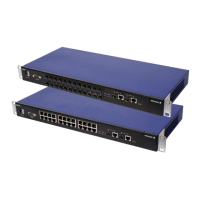IndexIndex
[enabled {no|yes}]
[link_trap_enabled {no|yes}]
[scheduling {none|sfq|sp|wfq}]
[speed {10|100}]
Arguments:
ethernet_port <port> - The number of the Ethernet port. Range 1-
26.
auto_negotiation no/yes – Set up the line automatically (yes) or not.
crossover auto/no/yes – Auto: The system does it automatically. No:
Straight through connection. Yes: Crossover set.
description – Description.
duplex full/half – The line is set up as full duplex or half duplex
connection.
enabled no/yes – Operational state set by operator.
link_trap_enabled no/yes – Defines whether changes in link state
(link up/down) for the port are sent as SNMP traps.
scheduling none/sfq/sp/wfq - Scheduling algorithm deciding the
order between packets sent over the egress port:
none = first in, first out
sfq = a combination of sp/wfq (Modified Deficit Round Robin)
sp = strict priority
wfq = weighted fair queuing (Deficit Round Robin)
speed 10/100 - 10 or 100 Mbps for Fast Ethernet (FE).
Note: In case the user needs to change the scheduling policy, e.g. asserting
the command set ethernet_port <port> scheduling
{none|sfq|sp|wfq} and on that <port> connections are
configured, then the configuration asserted will be visible in case a
get ethernet_port <port> is asserted but the configuration will
be active on the hardware only after a config save and then a
restore. This is outlined on the CLI by the following message:
*** WARNING!!!!

